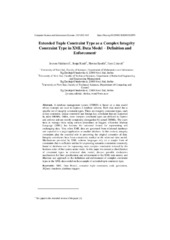Please use this identifier to cite or link to this item:
https://rfos.fon.bg.ac.rs/handle/123456789/1863Full metadata record
| DC Field | Value | Language |
|---|---|---|
| dc.creator | Vidaković, Jovana | |
| dc.creator | Ristić, Sonja | |
| dc.creator | Kordić, Slavica | |
| dc.creator | Luković, Ivan | |
| dc.date.accessioned | 2023-05-12T11:17:59Z | - |
| dc.date.available | 2023-05-12T11:17:59Z | - |
| dc.date.issued | 2018 | |
| dc.identifier.issn | 1820-0214 | |
| dc.identifier.uri | https://rfos.fon.bg.ac.rs/handle/123456789/1863 | - |
| dc.description.abstract | A database management system (DBMS) is based on a data model whose concepts are used to express a database schema. Each data model has a specific set of integrity constraint types. There are integrity constraint types, such as key constraint, unique constraint and foreign key constraint that are supported by most DBMSs. Other, more complex constraint types are difficult to express and enforce and are mostly completely disregarded by actual DBMSs. The users have to manage those using custom procedures or triggers. eXtended Markup Language (XML) has become the universal format for representing and exchanging data. Very often XML data are generated from relational databases and exported to a target application or another database. In this context, integrity constraints play the essential role in preserving the original semantics of data. Integrity constraints have been extensively studied in the relational data model. Mechanisms provided by XML schema languages rely on a simple form of constraints that is sufficient neither for expressing semantic constraints commonly found in databases nor for expressing more complex constraints induced by the business rules of the system under study. In this paper we present a classification of constraint types in relational data model, discuss possible declarative mechanisms for their specification and enforcement in the XML data model, and illustrate our approach to the definition and enforcement of complex constraint types in the XML data model on the example of extended tuple constraint type. | en |
| dc.publisher | ComSIS Consortium | |
| dc.relation | info:eu-repo/grantAgreement/MESTD/Basic Research (BR or ON)/174023/RS// | |
| dc.rights | openAccess | |
| dc.rights.uri | https://creativecommons.org/licenses/by-nc-nd/4.0/ | |
| dc.source | Computer Science and Information Systems / ComSIS | |
| dc.subject | XQuery functions | en |
| dc.subject | XML Data Model | en |
| dc.subject | extended tuple constraint | en |
| dc.subject | database triggers | en |
| dc.subject | code generation | en |
| dc.title | Extended Tuple Constraint Type as a Complex Integrity Constraint Type in XML Data Model - Definition and Enforcement | en |
| dc.type | article | |
| dc.rights.license | BY-NC-ND | |
| dc.citation.epage | 843 | |
| dc.citation.issue | 3 | |
| dc.citation.other | 15(3): 821-843 | |
| dc.citation.rank | M23 | |
| dc.citation.spage | 821 | |
| dc.citation.volume | 15 | |
| dc.identifier.doi | 10.2298/CSIS180324029V | |
| dc.identifier.fulltext | http://prototype2.rcub.bg.ac.rs/bitstream/id/520/1859.pdf | |
| dc.identifier.rcub | conv_3560 | |
| dc.identifier.scopus | 2-s2.0-85055143454 | |
| dc.identifier.wos | 000446686100017 | |
| dc.type.version | publishedVersion | |
| item.cerifentitytype | Publications | - |
| item.fulltext | With Fulltext | - |
| item.grantfulltext | open | - |
| item.openairetype | article | - |
| item.openairecristype | http://purl.org/coar/resource_type/c_18cf | - |
| Appears in Collections: | Radovi istraživača / Researchers’ publications | |
This item is licensed under a Creative Commons License


